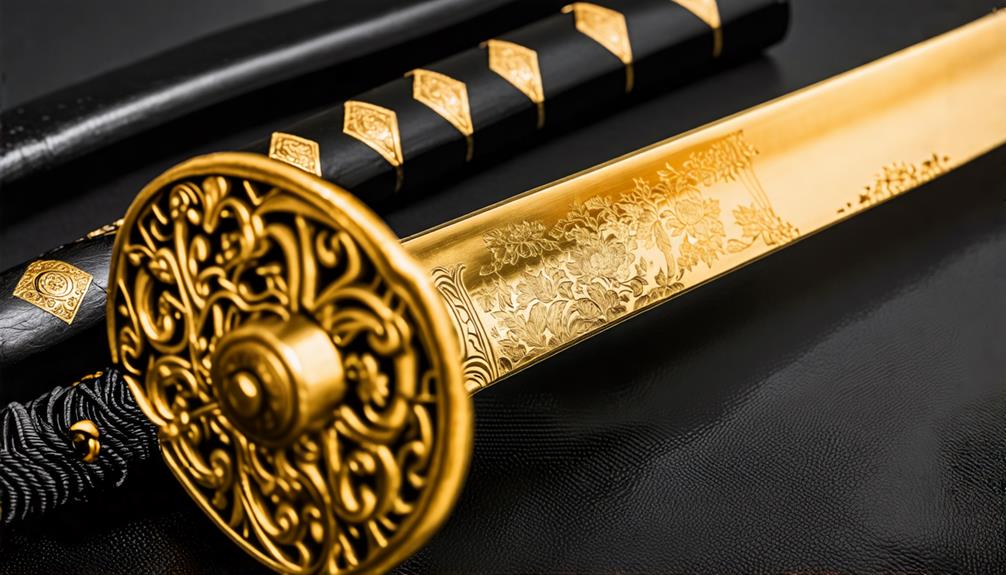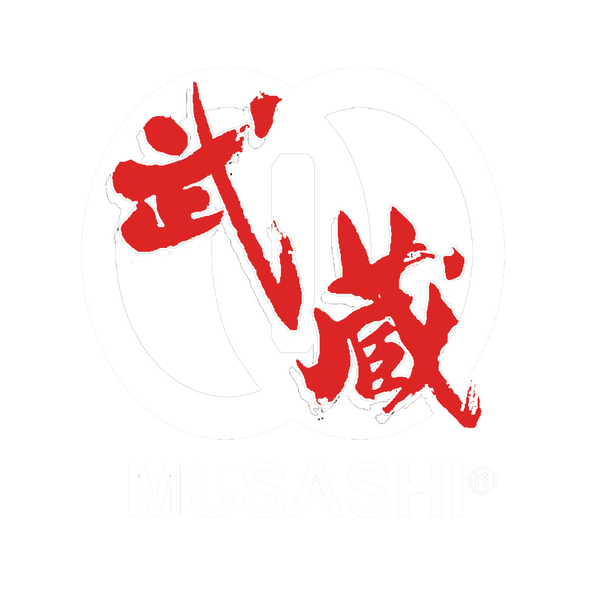
Gold katana swords mix beauty and usefulness in a special way. Long ago, they showed off wealth and power. Kings used them in big events and gave them as fancy gifts.
Skilled workers make these swords using special steel and carefully add gold designs. They use special tools to carve patterns. Today, makers use new methods like electroplating but still focus on making strong, easy-to-use blades.
People love to collect these swords and use them in martial arts. They blend old traditions with new ways of making things. Taking good care of these swords keeps them looking great for a long time.
There's a lot more to learn about how they're made and their exciting history!
Key Takeaways
- Gold katana swords blend aesthetics with functionality, historically symbolizing wealth and power.
- Skilled craftspeople use both traditional and modern techniques to create these swords, including special steel forging and gold detailing.
- The gold designs often carry symbolic meanings, adding cultural and artistic value to the swords.
- These swords feature functional elements like comfortable grips and balanced guards, making them suitable for martial arts displays.
- Proper maintenance, including special oils and display cases, is crucial for preserving the beauty and functionality of gold katanas.
The Art of Gold Detailing
Gold detailing on katana swords shows off amazing craftsmanship. Artists use old methods and new skills to add gold to the blade and its parts. They carefully put gold leaf or inlay on the sword to make it look better and mean more.

To do this, artists need to know a lot about metals and have steady hands. They make sure the gold sticks perfectly to the steel. Every gold design has a special meaning, often about strength, honor, or beauty. These aren't just for looks - they match what samurai believed in.
Adding gold takes a lot of skill. Artists must have very steady hands and sharp eyes to make sure everything lines up just right. This turns the katana from just a weapon into a work of art. The shiny gold looks amazing next to the smooth steel. It shows how katanas are important in both fighting and art.
Historical Significance
Gold katana swords are important in Japanese history. They show how warriors and artists worked together to make beautiful weapons. These swords weren't just for fighting. They also showed off the owner's wealth and status. Often, people in the royal family or top samurai had gold katanas.
Different times in Japanese history gave different meanings to gold katanas:
- Heian time: Used in royal ceremonies
- Kamakura time: Showed a warrior's high rank
- Muromachi time: Stood for power and loyalty
- Edo time: Displayed art and culture
- Meiji time: Represented national pride
In the Heian period, fancy swords with gold were used by rich people in the royal court. Later, in the Kamakura period, gold katanas became a sign of a warrior's importance.
During the Muromachi era, leaders gave these swords as gifts to show trust. The Edo period saw gold katanas become works of art, showing off great craftsmanship.
Craftsmanship Techniques
Making gold katana swords takes a lot of skill and old techniques mixed with new ideas. It all starts with picking the best steel called tamahagane. Skilled craftspeople fold and hammer this steel many times to make it strong and sharp.
Then, they carefully add gold to the blade, which makes it look amazing while still keeping its history. Artists play a big role in creating these swords. They use special tools to carve cool patterns on the blade. These designs aren't just for show - they prove how well-made the sword is.
One important pattern is called hamon, which comes from heating different parts of the blade in special ways. Today, sword makers use some new methods like electroplating and laser etching to make even fancier designs that last longer.
But the heart of a gold katana is still in the old ways of making it. Each sword shows how art and usefulness can work together perfectly.
Functional Design Elements
Gold katana swords blend old-style crafting with new design ideas to look good and work well in battle. The blade's shape is carefully made to cut powerfully while staying strong. Makers use tough steel, often with gold designs, to keep the blade sharp and long-lasting.
The grip is another important part. It's usually covered in rough fish skin and silk or cotton. This makes it comfortable to hold and easy to control. Gold touches on the grip show off the maker's skill in mixing useful and pretty parts without hurting how well the sword works.
Strong materials are used for other parts too, like the guard and scabbard. The guard, often made from strong metal with gold designs, protects the hand and keeps the sword balanced.
The scabbard, made from wood and coated to last, often has gold leaf or powder on it. This makes the katana both a useful weapon and a beautiful piece of art.
Modern-Day Applications
Gold katana swords are still important today in martial arts, special events, and as fancy collectibles. In martial arts, people often want custom-made swords that look good and work well. While gold swords aren't the best for hard training, they're great for shows where looks matter. The skilled makers ensure these swords still work properly, even with their fancy appearance.
At special events, gold katanas stand for honor and importance. People use them in Japanese weddings, tea ceremonies, and big official gatherings. These swords add cultural meaning and make everything look more special. The detailed designs often show pictures and patterns that match the event's culture.
Collectors love gold katanas because they're rare and beautifully made. They buy these swords not just for decoration, but also because they're historically accurate and show great skill. Custom designs made just for the buyer make these swords even more valuable. They're a unique mix of art and usefulness that many people admire.
Collecting and Preserving
Collecting and taking care of gold katana swords is a careful job that needs a good understanding of how they were made in the past. Collectors first need to make sure the sword is real by checking its history. They look closely at the blade's wavy line, called a hamon, and the part that goes into the handle, called a nakago. These parts tell them when and where the sword was made.

Keeping gold katana swords safe requires special skills. Collectors need to store the swords in places where the air isn't too wet or too dry, and the temperature stays the same. This stops the sword from rusting or getting damaged. They also put special oil on the blade to keep it clean and shiny without hurting the gold parts.
Showing off these swords is tricky. Collectors use special cases with glass that blocks harmful light. The inside of the case is made with materials that won't hurt the sword's metal or lacquer.
Smart collectors also ask experts to check their swords often. This way, they can fix any problems quickly and keep these important old swords safe for people in the future to see and enjoy.
Frequently Asked Questions
What Is the Typical Cost Range for a Gold Katana Sword?
Gold katana swords are super expensive! They can cost anywhere from $10,000 to $50,000, and sometimes even more. The price depends on how fancy the sword is and how closely it matches real historical swords. These swords are made by expert craftsmen who put a lot of work into making them look amazing and luxurious. If you want one of these gold katanas, you'll need to save up a lot of money!
Are Gold Katana Swords Practical for Martial Arts Training?
Gold katana swords look cool, but they're not the best for martial arts training. They focus more on looking good than working well. Regular katanas are better for practice because they're stronger and more balanced. Gold swords might break easily or feel awkward when you use them. If you want to improve your skills, stick with traditional katanas instead of flashy gold ones.
How Can You Distinguish a Genuine Gold Katana From a Replica?
Real gold katanas stand out from fake ones in a few key ways. Look closely at how they were made and their history. Real ones use old-school forging methods and have special wavy patterns on the blade. The small parts, like the handle, are also very detailed. True katanas are made with better metal and often have marks from famous sword makers. By checking these things, you can tell if a katana is the real deal or just a copy.
What Types of Gold Are Commonly Used in Katana Detailing?
Sword makers often use 18k and 24k gold to decorate katanas. These different gold types show how pure the gold is. Japanese craftspeople are really good at adding thin layers of gold to swords. This shows how important and detailed traditional sword-making is in Japan. The gold makes the katanas look amazing and connects them to history.
Are There Any Cultural Taboos Associated With Owning a Gold Katana?
Some people might frown upon owning a gold katana because it goes against old traditions. In the past, katanas were meant to be useful tools, not flashy objects. While there are no official rules against having one, some folks might think it's disrespectful or brings bad luck. Remember, these are just beliefs and not everyone will feel the same way. If you want a gold katana, it's up to you to decide if it fits with your values and the people around you.
Conclusion
Gold katana swords are really cool! They mix old Japanese sword-making skills with fancy gold designs. These swords look amazing and show off the maker's talent. While they're not the best for martial arts practice, they're great for showing off or collecting. People who love swords often want gold katanas because they're special and beautiful. Just remember, these swords need lots of care to keep them looking good.
If you want to see some awesome katanas, check out Musashi Swords. We have all kinds of cool swords that look great and are made well. Whether you want a sword for practice or just to display, Musashi Swords has something for you.


